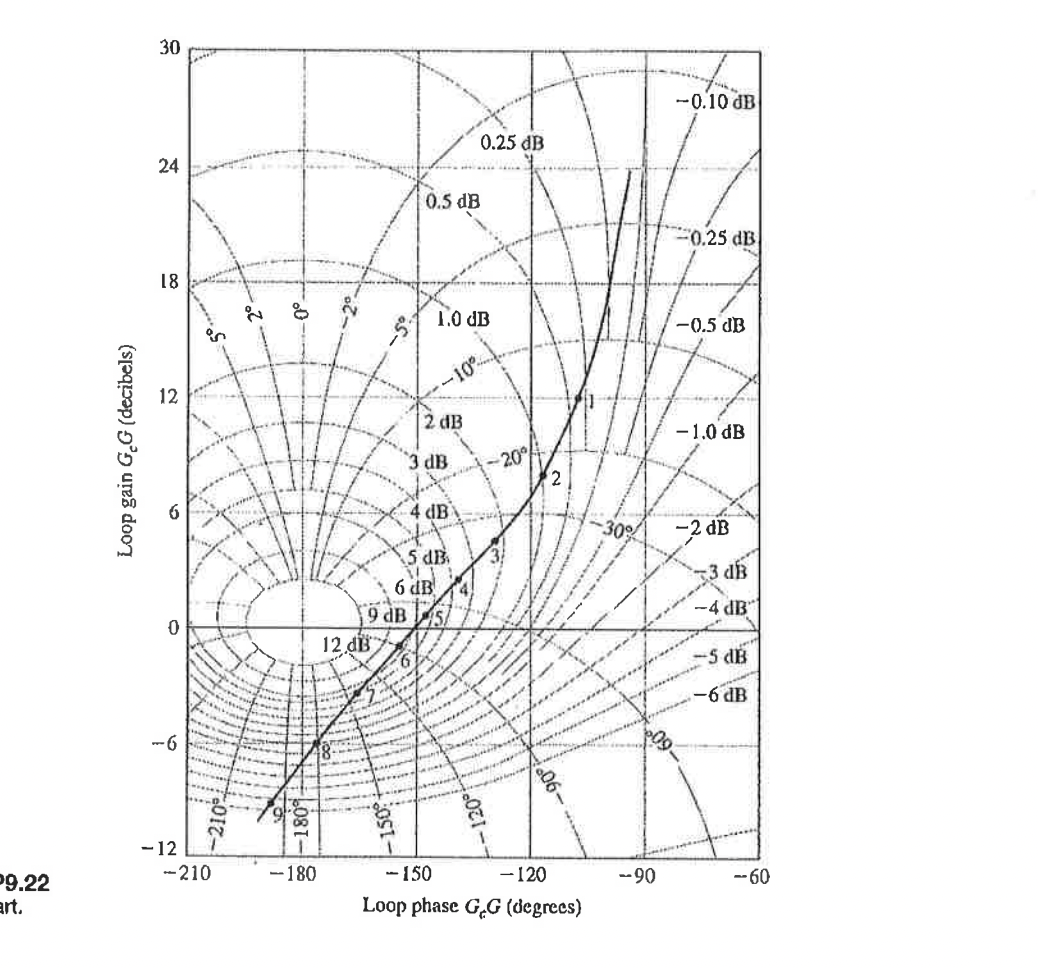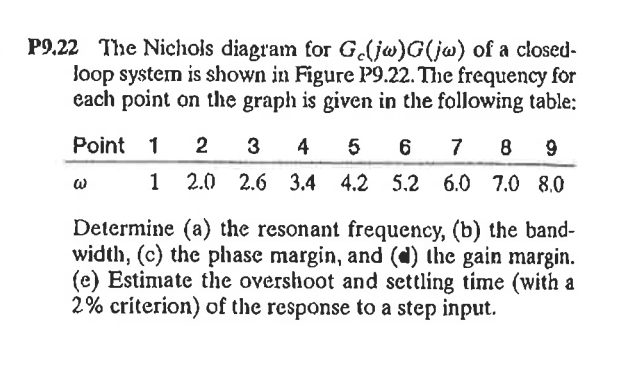P9.22 The Nichols diagram for Gljw)G(jw) of a closed- loop system is shown in Figure P9.22. The frequency for each point on the graph is given in the following table: Point 1 7 8 9 1 2.0 2.6 3.4 4.2 5.2 6.0 7.0 8.0 2 3 4 6 Determine (a) the resonant frequency, (b) the band- width, (c) the phase margin, and (d) the gain margin. (e) Estimate the overshoot and settling time (with a 2% criterion) of the response to a step input.
P9.22 The Nichols diagram for Gljw)G(jw) of a closed- loop system is shown in Figure P9.22. The frequency for each point on the graph is given in the following table: Point 1 7 8 9 1 2.0 2.6 3.4 4.2 5.2 6.0 7.0 8.0 2 3 4 6 Determine (a) the resonant frequency, (b) the band- width, (c) the phase margin, and (d) the gain margin. (e) Estimate the overshoot and settling time (with a 2% criterion) of the response to a step input.
Introductory Circuit Analysis (13th Edition)
13th Edition
ISBN:9780133923605
Author:Robert L. Boylestad
Publisher:Robert L. Boylestad
Chapter1: Introduction
Section: Chapter Questions
Problem 1P: Visit your local library (at school or home) and describe the extent to which it provides literature...
Related questions
Question
please only do d and e. thanks

Transcribed Image Text:30
-0.10 dB
0.25 dB
24
0.5 dB
0.25 dB
18
1.0 dB
-0.5 dB
12
2 dB
-1.0 dB
20
2
3 dB
4 dB
-2 dB
5 dB
3 dB
6 dB 4
9 dB5/
-4 dB"
12 di
-5 dB
HP 9-
-6
-12
--210
-180
- 150
-120
--90
--60
P9.22
art.
Loop phase G.G (degrees)
Loop gain G.G (decibels)
6081-
-150°

Transcribed Image Text:P9.22 The Nichols diagram for G.ljw)G(jw) of a closed-
Joop system is shown in Figure P9.22. The frequency for
each point on the graph is given in the following table:
Point 1
2
3
4
5
7
8 9
1
2.0 2.6 3.4
4.2 5.2 6.0 7.0 8.0
Determine (a) the resonant frequency, (b) the band-
width, (c) the plhase margin, and (d) the gain margin.
(e) Estimate the overshoot and settling time (with a
2% críterion) of the response to a step input.
Expert Solution
This question has been solved!
Explore an expertly crafted, step-by-step solution for a thorough understanding of key concepts.
This is a popular solution!
Trending now
This is a popular solution!
Step by step
Solved in 2 steps with 2 images

Knowledge Booster
Learn more about
Need a deep-dive on the concept behind this application? Look no further. Learn more about this topic, electrical-engineering and related others by exploring similar questions and additional content below.Recommended textbooks for you

Introductory Circuit Analysis (13th Edition)
Electrical Engineering
ISBN:
9780133923605
Author:
Robert L. Boylestad
Publisher:
PEARSON

Delmar's Standard Textbook Of Electricity
Electrical Engineering
ISBN:
9781337900348
Author:
Stephen L. Herman
Publisher:
Cengage Learning

Programmable Logic Controllers
Electrical Engineering
ISBN:
9780073373843
Author:
Frank D. Petruzella
Publisher:
McGraw-Hill Education

Introductory Circuit Analysis (13th Edition)
Electrical Engineering
ISBN:
9780133923605
Author:
Robert L. Boylestad
Publisher:
PEARSON

Delmar's Standard Textbook Of Electricity
Electrical Engineering
ISBN:
9781337900348
Author:
Stephen L. Herman
Publisher:
Cengage Learning

Programmable Logic Controllers
Electrical Engineering
ISBN:
9780073373843
Author:
Frank D. Petruzella
Publisher:
McGraw-Hill Education

Fundamentals of Electric Circuits
Electrical Engineering
ISBN:
9780078028229
Author:
Charles K Alexander, Matthew Sadiku
Publisher:
McGraw-Hill Education

Electric Circuits. (11th Edition)
Electrical Engineering
ISBN:
9780134746968
Author:
James W. Nilsson, Susan Riedel
Publisher:
PEARSON

Engineering Electromagnetics
Electrical Engineering
ISBN:
9780078028151
Author:
Hayt, William H. (william Hart), Jr, BUCK, John A.
Publisher:
Mcgraw-hill Education,